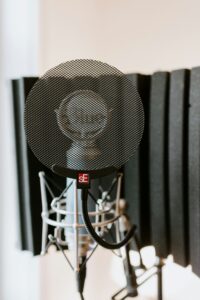
To breathe or not to breathe? That is the question – in voice-over work, that is. Our breath can make a lot of
difference in what we’re recording. Sometimes for the better, sometimes for the worse, and sometimes it may
completely disrupt the audio as a whole. The difficulty with all of these different outcomes is knowing when you should eliminate breath noise altogether, and when it actually adds something to what you’re recording.
There are two things to consider when you’re making this decision. First is a simple “yes or no” question – has the client specifically asked for you to leave breath in or cut all breath out? If yes, then you’re in luck. No need to think about it any further, just do what the client asked for! Your first step for any audition or project should simply be following the client’s directions.
If the client hasn’t specified, which tends to be a bit more common, then you must decide based on the type of project you’re working on. In short, we can break it down this way:
When to Leave In Breath
Audiobooks, E-Learning, Corporate Narration, Medical Narration, and most other long-form narrative work. Even a blog post’s voice-over! Breathing here, especially in audiobooks, is part of the performance! It will actually help you sound more natural, which is what we want in long narration. When reading a book out loud, you’ll naturally need to breathe, so leave that in! As with everything, if you have one breath that’s much louder or abnormal compared to your usual breathing, then by all means cut it out or reduce its sound. But in general, there’s no need to cut breaths here. Let’s thank our lucky stars for that, right? I know I wouldn’t want to cut hours of breathing out of an audiobook!
When to Leave Breathing that Adds to the Scene
This would apply to character work in animation, video games, etc. If your breathing is part of the acting of your lines, definitely leave it! If you’re reading a monologue, for example, leave your breath in. If you’re just gasping after a long line or taking a deep breath before a take, but it isn’t part of what your character would do in that moment, you can cut it out.
When to Remove Breath
Commercial work! If the script doesn’t specifically call for a gasp, yawn, inhale or exhale, you should remove all breathing from any commercial you’re working on. Commercials also need to fit within a certain amount of time – typically 15, 30, or 60 seconds. Depending on how much time you have to fill, you may or may not want to leave silent spaces between sentences where breathing normally would be, or remove the space and breath altogether to make a faster sounding read. This part is up to you, your client, and the amount of time you have to work with. Unless the client demands it, we remove breathing from these projects!
In any of these situations, use your best judgment and your fine-tuned ear for voice-over. Frequent disruptive breathing might mean that you’re standing too close to the mic, or facing it head-on. Try to keep about six inches away from the mic on average, and tilt it a little bit above, below, or to the side of your mouth. This’ll also help prevent mic pops! If you’re a generally loud breather, it’s ok: practice taking more regular, smaller breaths from your mouth (not your nose!) and keeping your throat warmed up and relaxed.
Leaving or removing breath can add to a performance, so let this article guide you into a better, happier recording! Inhale, exhale.
Check out our free PDF with pro-tips from real working voice-over actors here!
Want to learn more about voiceover? Signup for our introductory VO webinar.





